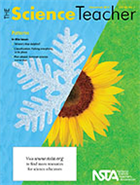Patterns
By Mary Bigelow
Posted on 2013-12-08
 Patterns is one of the crosscutting concepts in the Next Generation Science Standards (NGSS). As the Science Scope editor notes, “recognizing patterns is arguably the most central to the scientific enterprise.” Even if you’ve never thought much about this, you and your students have noticed and worked with patterns: symmetry in living things, snowflake design, movement of weather fronts, the Periodic Table, life cycles of living things, Newton’s Laws, the structure of DNA, seasons, phases of the moon, etc. The featured articles in this issue illustrate lessons that capitalize on our ability to notice and work with patterns to get to a deeper understanding of the world around us.
Patterns is one of the crosscutting concepts in the Next Generation Science Standards (NGSS). As the Science Scope editor notes, “recognizing patterns is arguably the most central to the scientific enterprise.” Even if you’ve never thought much about this, you and your students have noticed and worked with patterns: symmetry in living things, snowflake design, movement of weather fronts, the Periodic Table, life cycles of living things, Newton’s Laws, the structure of DNA, seasons, phases of the moon, etc. The featured articles in this issue illustrate lessons that capitalize on our ability to notice and work with patterns to get to a deeper understanding of the world around us.
The authors of Where’s That Dolphin?* describe an activity in which students analyze spatial data from dolphins and map their movements to explore spatial data and patterns of movement. The data is available online, so you don’t have to live near the water! [SciLinks: Marine Mammals, Mapping]
What do the geologic time scale, the Periodic Table, and taxonomy have in common? Classification* is a basic process in science and depends on recognizing patterns. The authors provide some background into the life of Linnaeus and describe a class activity in which students apply pattern recognition and classification using a collection of paper fasteners (I suppose other objects could be used?). They then use their categories to develop a hierarchy (corresponding to order, family, genus), and finish by constructing a cladogram. [SciLinks: Classification]
Patterns are not just related to physical characteristics. The lessons in What Makes Us Tick…Tock? investigate questions related to circadian rhythms and how environmental factors and genetics influence them. In addition to studying simulations of fruit fly behaviors (described in the article), students extend their learning to human behavior patterns. [SciLinks: Rhythms of Life]
*Don’t forget to look at the Connections for this issue (December 2013). Even if the article does not quite fit with your lesson agenda, this resource has ideas for handouts, background information sheets, data sheets, rubrics, etc.
Disclaimer: The views expressed in this blog post are those of the author(s) and do not necessarily reflect the official position of the National Science Teaching Association (NSTA).


